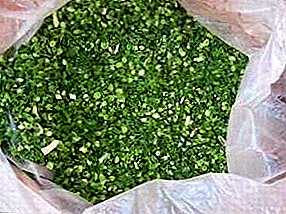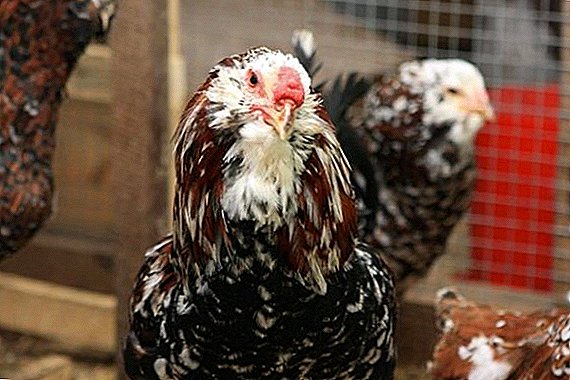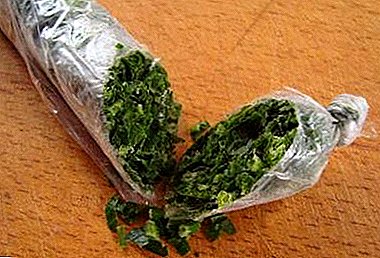
To get an early and rich harvest of eggplants, it is necessary to sow the seeds on seedlings in time. Approximate time - no later than mid-February, regardless of the type of soil. Many people sow eggplant seeds in March - early April, with the result that the plants bloom only at the end of summer. The vegetative period of eggplants lasts more than one hundred days.
Before planting seeds they need to check for germination. To do this, it is enough to carry out the following procedure: take ten seeds of eggplants, arrange them into small sacks, then place them in warm water for twenty-four hours. Then get out of the water, put the bags in the bowl and put in a warm place, for example, near the battery. Keep the bags wet. In five days you will understand whether the seeds will grow or not. Even if only seven of the fifteen seeds have sprouted, they are suitable for sowing.
We protect the seeds of eggplant from pests
 Before planting, the seeds should also be decontaminated in a strong solution of pharmacy manganese for half an hour. After that, rinse with water, and moisten in a nutrient solution. To obtain it you need to dissolve one teaspoon of wood ash in one liter of water. Instead of ashes, liquid sodium humate or nitrophoska will do.
Before planting, the seeds should also be decontaminated in a strong solution of pharmacy manganese for half an hour. After that, rinse with water, and moisten in a nutrient solution. To obtain it you need to dissolve one teaspoon of wood ash in one liter of water. Instead of ashes, liquid sodium humate or nitrophoska will do.
The seeds are dropped into the solution in bags for twenty-four hours. The temperature of the solution should not be below +28 degrees. Thanks to this treatment, eggplants will grow faster, and you will be able to harvest earlier than others.
Now you need to remove the bags of seeds from the solution, sprinkle a little with water, put on a plate and leave for two days in a warm place. Seeds must slip. After using these seeds, they will grow in five to six days.
Tips on how to grow eggplant seedlings.
See here for tips on growing and caring for tomatoes.
The rubric is devoted to the cultivation of vegetables in open ground //rusfermer.net/ogorod/plodovye-ovoshhi/vyrashhivanie-v-otkrytom-grunte
To harden the seeds they can be affected by contrasting temperatures.
This is done like this: The seeds are placed in a refrigerator for two days, the temperature in which is no more than five degrees, then they are put in a warm place at a temperature of + 20 for a day, and then again in a refrigerator for two days. From the refrigerator, seeds are sown immediately in boxes. Remember that the seeds in the bags must always be hydrated.
Eggplant Care and Parasite Prevention
You can grow eggplant in different soil. Here are some compounds you can use:
- Two parts of manure and one part of land;
- One part of sawdust, two parts of peat and the same amount of humus;
- Two parts of humus and peat;
- Two parts of the earth and three parts of the humus;
- The most convenient way is to buy the ready-to-live soil in the store.
Now you can add one spoon of wood ash and superphosphate to one of the selected soil mixes, mix them thoroughly and add them to the box. Leave a distance of at least two centimeters from the soil to the top of the box, so that when watering the soil is not washed out.
 The soil mixture must be poured into the box with an eight centimeter layer. Then level it, compact it and make holes at a distance of five centimeters from each other. Do not forget to water the soil. Put the seeds in the hole two centimeters from each other, to a depth of about one and a half centimeters. Then fill the pits, and slightly soil the soil.
The soil mixture must be poured into the box with an eight centimeter layer. Then level it, compact it and make holes at a distance of five centimeters from each other. Do not forget to water the soil. Put the seeds in the hole two centimeters from each other, to a depth of about one and a half centimeters. Then fill the pits, and slightly soil the soil.
The box with crops is left for two days in a warm place. Two days later, the soil is watered with three tablespoons of water in each drawer.
So seedlings quickly ascend.
For five to six days, the seedlings must be monitored, and as soon as they grow up, the box must be moved to the sunniest place in the apartment.
Seedlings should be in the box until they give the first two true flowers. It usually takes about a month. During this time, seedlings need to be watered once a week. Over-watering is not worth it, otherwise the risk of infection of plants with a black leg is high.
The water temperature should be about +25 degrees. Pre-water need to defend. Top dressing before transplanting plants to another container is performed once from the ratio: ten liters of water for one spoonful of calcium nitrate solution.
Two days later, the boxes must be turned to the window so that more light comes to the plants.
After two true leaves are seen from the ground, the future eggplants are ready for transplanting. Seedlings at this time it is much easier to replant than during the period of the appearance of cotyledon leaves.
 Before you begin the procedure of picking, seedlings three hours before it is watered. It is not recommended to get seedlings from dry soil, since all the soil from the roots will crumble.
Before you begin the procedure of picking, seedlings three hours before it is watered. It is not recommended to get seedlings from dry soil, since all the soil from the roots will crumble.
Seedlings can be transplanted into milk bags, peat pots, plastic cups etc. The size of the container should be 10x10 cm. It is filled with soil mixture, which was used for sowing seeds. Then it is watered at the rate of: 10 liters of water per glass of liquid mullein or one tablespoon of urea.
After the pots are filled with the nutrient mixture, make them in the middle of the fossa, and plant the plant deep into the first leaflets on the stem.
Seedlings in pots are placed near the window, while covering it for a couple of days with a newspaper in order to create conditions of moderate lighting. Caring for seedlings - is feeding, watering, hardening and compliance with the temperature regime.
Water the soil regularly. For the first time in a week it is necessary to pour all the soil. So that the water does not stagnate in the pot, it is necessary to make holes in its bottom. If you pour too much water, the plants may stop growing. Water it with settled water, six days after transplanting.
If you notice that the growth process is moving very slowly, and the leaves of the plant turned green, then prepare the following composition: dissolve one cup of mullein and a teaspoon of urea in ten liters of water. Feed the eggplants.
Twice during the ripening of eggplants, pour a little wood ash into the soil. For three pots enough one teaspoon. Pour the ash carefully so that it does not fall on the plants.
To make plants better settled down, immediately after picking, provide them with warm air in the room.
Pumpkin. Planting and care are helpful tips.
How to grow cucumbers at home //rusfermer.net/ogorod/plodovye-ovoshhi/vyrashhivanie-v-otkrytom-grunte/pravilnoe-vyrashhivanie-ogurtsov-v-otkrytom-grunte.html
Planting eggplant seedlings in open ground
Transplant eggplants in open ground need when the seedlings will give from eight to twelve leaves. It should also have a strong root system and buds formed. If eggplants can be grown in a greenhouse, then do it from the middle of May, maybe a little earlier.
The seedlings are planted in open ground in early June. The beds should be securely covered with foil. Before planting the soil in the pots must be watered. This is necessary so that a moist lump of earth remains on the roots of the plants.
The main diseases of eggplant seedlings
To prevent the inevitable death of a plant, it is necessary to have a good understanding of the causes of the disease, as well as to know its distinguishing features.
The most common disease affecting eggplants is "blackleg". The reason for all - the fungus, which causes darkening of the root neck of the plant. If you do not take urgent measures, the disease will cover the whole flower, and it will gradually fade. In places of high humidity the disease spreads in a matter of hours.
It is impossible to cure a plant after a black leg injury, but the disease can be prevented.
Disease prevention
 The infected flower must be removed urgently, and the soil in this place should be disinfected with bleach. Seedlings should be thinned regularly. The most dangerous are bacterial diseases, such as "black bacterial spotting". The whole plant suffers from it.
The infected flower must be removed urgently, and the soil in this place should be disinfected with bleach. Seedlings should be thinned regularly. The most dangerous are bacterial diseases, such as "black bacterial spotting". The whole plant suffers from it.
It is covered with black spots, with a yellow border on the sides. The spots start to grow until the whole plant is covered. If this happens, then eggplants are not suitable for food. To prevent the occurrence of the disease, spray the plants with the bacterial drug "Barrier" - three caps per liter of water.
Other diseases include:
- verticillis;
- gray rot;
- fomosssis.
Eggplant seedling pests
 The most notorious pest of eggplants is Colorado beetle. And he loves them more than potato stalks.
The most notorious pest of eggplants is Colorado beetle. And he loves them more than potato stalks.
The second most popular is spider mite. The bush from its activity becomes holed with small holes. Spider mite can completely suck all the juices from the plant, if not to take action. Two to three weeks later, a new offspring of pests appears.
Loves eggplant and aphid. She also sucks the juice from the plant. To prevent its occurrence, it is necessary during the flowering stage to spray eggplant with such chemical preparations as: “Aktara” or “karbofos”. They are actually suitable for the destruction of all pests.
Find out when the right time for planting fruit trees, what would they quickly began and gave the first shoots.
All that you did not know about the device hive, read our article for beekeepers - beginners here.
But in order to get rid of bare slugs, it is necessary to keep the landings clean, pollinate the grooves with fresh lime and regularly loosen the soil.


 Tips on how to grow eggplant seedlings.
Tips on how to grow eggplant seedlings.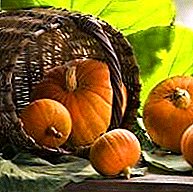 Pumpkin. Planting and care are helpful tips.
Pumpkin. Planting and care are helpful tips.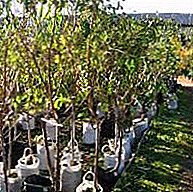 Find out when the right time for planting fruit trees, what would they quickly began and gave the first shoots.
Find out when the right time for planting fruit trees, what would they quickly began and gave the first shoots.

